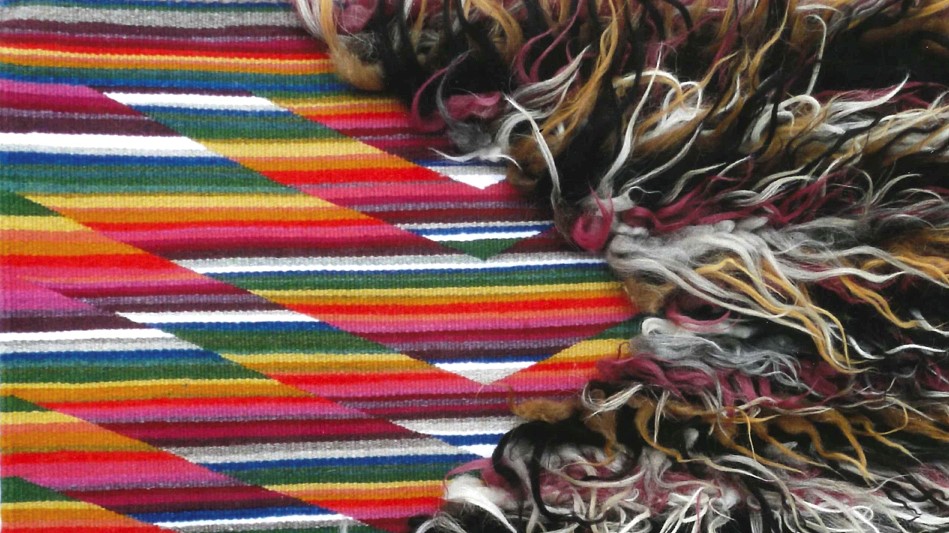Guest post by Sháńdíín Brown, SAR Anne Ray intern, 2020–2021
Venancio Aragon is the SAR 2020 Rollin and Mary Ella King Native artist fellow. From September to December, he lived on the SAR campus and worked in the Dubin Studio. As an Anne Ray intern, I was fortunate to spend some time with him and converse about various topics, such as current politics, organic produce, and, of course, his work as an artist. If you ever meet Venancio, you will notice his friendly demeanor and willingness to chat. He is a citizen of the Navajo Nation and what I would consider an award-winning master weaver, although he describes himself as “a humble practitioner of an ancient art.” Along with being an artist, he is also an intellectual, knowledge holder, and student.

Venancio Aragon. Photo courtesy of the artist.

A work in progress by Venancio Aragon (Navajo).
Venancio learned to weave at age ten from his mother, Irveta Aragon, but he also has learned techniques from studying older Navajo rugs and figuring out how past artists created specific designs. At SAR, Venancio spent his time researching the Indian Arts Research Center collections’ plethora of Navajo textiles and integrating that research into his weavings when working in the studio. He told me that he views weavings as living things, as taught to him by Navajo stories. When viewing the textiles in the IARC collection, he said he felt a bit sad that they are stored alone in the dark place that is the IARC vault. We chatted about how Western museum theory thrives on preserving material objects’ tangibility for as long as possible compared to Indigenous understandings that material objects are not meant to exist forever. However, Venancio mentioned that the great benefit of Western museum theory is studying and learning from the historical preserved items, like the Navajo textiles at the IARC.
With the knowledge and techniques that Venancio learns from these items, he reaches out to other Navajo weavers:
I’m very open to help people with the knowledge that I have because if I were to hoard that knowledge, it wouldn’t help anybody but myself. And if people before me didn’t open up to me and share, I wouldn’t know what I know about weaving. We become vessels for these knowledges to grow and cultivate within us. And then we pass them on. That’s the way things survive.
Venancio is not what most people would consider a traditional Navajo weaver. His work is unique and utilizes beautiful bright colors and bold geometric designs. He told me, “We as Navajo artists are free today to articulate our narratives, question the constructions of what is traditional and what is contemporary, and challenge what Navajo weaving is supposed to look like. The purest essence of Navajo weaving is for one to have freedom and creativity and to bring beauty into the world.” And bringing beauty into the world is precisely what Venancio does with his textiles. When I asked him what the inspiration was behind his vivid color scheme, he told me,
I personally like interesting bright colors, and it’s just how my mind works. When I weave, I try to create something so overwhelming to the senses with color and geometry that it moves people with emotion. If you look at the natural world, you will see all kinds of colors and order in chaotic formations. The rainbow is the brightest thing in nature, I take that sequence of colors, and I break it up into multiple components, adding more and more colors. My weaving creates a prism of all the colors of the world.

Venancio Aragon (Navajo). Two Stories, 2017. Handspun Navajo Churro wool, 28″ x 38″. Photo courtesy of the artist.
When I asked Venancio about the direction he saw his weaving taking after completing his fellowship, he said,

Venancio Aragon (Navajo). Texture and Movement (front view, detail), 2018. Merino and Navajo Churro wool fiber (tapestry and tufted technique), 3′ x 4′. Photo courtesy of the artist.
My time here at SAR has reinvigorated my interest in experimentation because when you’re trying to make art to sell, you have standard things that you create. But being here and having the support of the fellowship, time to relax, and the ability to go to the collections, I’ve been reinvigorated in experimentation. I think many of my upcoming pieces will keep expanding on what I know and what I’ve learned. When I get back home to my studio, I want to set up a bigger piece that takes a lot longer than the smaller pieces I’ve been working on here. We must help our country by socially isolating and staying out of crowded spaces during this pandemic. And for an artist like me, where I work solo and best in quiet places, that’s something I can do during this terrible time we’re living in.
To see what Venancio creates next and learn more about him, you can visit his website: https://www.venancioaragon.com. Additionally, Venancio is featured in the documentary Spider Woman’s Web, which you can watch for free at https://vimeo.com/294168308.
